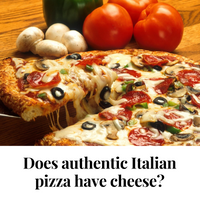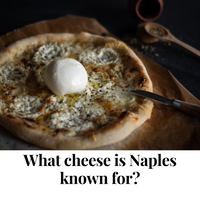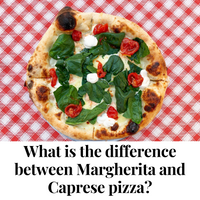
Italian Fast-Casual is a distinct restaurant genre. Fast-Casual is all about excellent cuisine and fast service. Italian food is ideal for this market since it is interesting, adaptable to every appetite, and affordable, allowing restaurant operators to keep affordable prices.
In the midst of eating pizza peacefully, you may ask yourself, "is pizza a fast casual Italian dish or a delicacy?" Well, pizza started out being a peasant food, and now it's fast-casual.
Hence, today in our article, we will include everything you need to know about the history of pizza, eating styles in different regions, and more. Without any further ado, let's start!
Why Pizza Works As Fast Casual Italian?
Fast-casual dining has been thriving to make food easy to go while also being healthy and convenient. Almost every cuisine has its fast-casual version. However, Italian food truly does stand out with their ever-so-famous pizza.
According to different sources, Italian food is the best food in the world. Pizza started out being a regular food for the Italians. However, as the world progressed, Italian immigrants brought pizza to America. As we all know, now it's served as one of the most popular fast-casual dishes.
The best part about pizza is that it's not considered to be junk food. It has every element that your food pyramid requires—eating pizza once a week is deemed healthy!
The History of Pizza
Pizza is internationally a fast-casual item. Almost every kid, adult, and even elderly love to engulf in the cheesy goodness of Italian pizzas. Now they've evolved into different forms, sizes, and shapes.
However, the essence of authentic Italian pizza remains evident in every bite of a good pizza slice from Pizza Bien. To know about the roots of pizza and where it originated from, we'll be going into the depths of it.
Where Did Pizza Originate?
There are two main styles of American pizzas in the United States: the thick and cheesy Chicago Style and the thin and classic New York Style. A pizza may be classified as either Italian or international.
One slice of genuine Italian pizza is all it takes, despite its simple ingredients. This simple and delicious dinner will transform your life. Let's learn more about the history of pizza.
Pizza, a seasoned flatbread, has a long and illustrious Mediterranean heritage. The word "pizza" is derived from the Latin pinsa, meaning flatbread.
The Greeks and Phoenicians ate the wheat-and-water flatbread. Baking occurs on a stone at high heat with herbs.
Even while it wasn't pizza yet, it was very comparable to today's modern focaccia. Legend says that Herodotus and Cato the Elder hailed the early pizzas eaten from Rome to Egypt to Babylon.
Rome's occupying troops developed a taste for Jewish Matzoth and carried it home. But archeologists found a Bronze Age pizza in the Veneto region in Italy. They started to look and taste more modern by the Middle Age. They were referred to as "early pizzas."
There were few ingredients available to them, and they used olive oil and herbs to top their pizza dough. Farmers made mozzarella cheese from Indian Water Buffaloes. Even now, fresh mozzarella di bufala is still used on pizza in Italian cuisine.
Although many American pizza joints utilize dried shredded cheese in place of fresh mozzarella, no Italian pizzeria does.
Local pizza chefs first introduced onion and tomato products to Italian cuisine in the mid-1800s. They thought that tomatoes were poisonous when they first arrived in Italy in the 1530s and were only grown for show. Several early pizzas were created by Napoletan peasants who used the supposedly lethal fruit.
However, it took a long time for society to accept this unrefined peasant food. The Neapolitan aristocracy loved pizza so much that it was now being sold on the streets of Naples for every meal.
Due to the popularity of pizza, street vendors gave way to Italian restaurants where customers could create their custom-made pizza. Napoli's "Antica Pizza Port'Alba '' opened in 1830 and is still producing wonders today.
Types of Traditional Italian Pizza
Neapolitan pizza has been deemed an STG by the EU since 2010. As to STG, Neapolitan pizza is a recognized traditional specialty, with all of its elements controlled, including ingredients, form, cooking, and consumption.
Since people must eat them at the same place where they were produced, take-out pizzas do lose their STG designation. Thus, the Neapolitan pizza's uniqueness is preserved by adhering to strict manufacturing requirements.
Right after the Neapolitan in the pizza chronology is the classic Italian pie. In Italy, the most popular pizza is the Margherita, but there are several variants of it.

Pizzeria pizza is always circular in a wood-fired oven. Oregano, anchovies, and garlic flavor are used for the classic Neapolitan pizza Marinara. The freshest capers and olives from Puglia and mushrooms and prosciutto Crudo from Verona are also famously used. Some topping options are green olives, prawns, and pea.
Several kinds are popular throughout the country, despite regional differences. Quattro Formaggi regionally-specific four-cheese mix is made from four different cheese types: mild mozzarella to strong fontina or taleggio Toppings such as anchovies and shrimp may also be seen on a pizza.
Quattro Stagioni is another famous Italian pizza. With artichokes and Prosciutto Cotto salami. Pizza with basil pesto and no tomato sauce is famous in Liguria. And there's much more to discover!
Contemporary Pizzas and Flatbreads
Italians love various pizzas, including classic pizza and flatbreads, which have a long history in Italy. Here are a few of the best!
Everywhere in Italy, you may get pizza al taglio, also known as pizza Rustica, sold by the pound. As a fast lunch option, this pizza is often sold at street vendors on a sheet pan.
Focaccia is characteristic of Liguria and has a thicker foundation than pizza, with extra virgin olive oil and rosemary sprinkling on top. The pizzerias may use various toppings, such as olives, caramelized onions, and cheese.
Thick, Sicilian pizza made with tomatoes, anchovies, breadcrumbs, and caciocavallo cheese is widely famous.
No surprise here, but it's an Italian calzone that's smaller than its American counterpart. Traditional Italian pizzerias are attempting to keep up with this new trend by utilizing unusual ingredients. Pizza is now served in different Italian restaurants alongside fast food pasta.
These are our top picks for the history of pizza, the classic Italian pizza, and the various kinds of pizza you may get your hands on today. Let us know whether you're ready to savor and adore.
The Difference Between American & Italian Pizza
Pizza is a globally popular meal. It is an Italian meal (specifically a Neapolitan dish) that has spread across the world. However, pizza is more than a popular dinner; it is one of the most reinterpreted foods, with regional variants. Pizza may be served as a main course or as a street snack in slices. Additionally, there are two distinct types of pizza: traditional Italian and American.
Americans are credited with inventing the world's most famous pizza. Outside of Italy, two of the most well-known American businesses that serve this dish are Pizza Hut and Domino's Pizza. Whatever the case, the pizza prepared by these and other businesses is not genuine Italian pizza.
The primary difference is in how people see pizza: in Italy, pizza is a light food (the most famous variation is the pizza Margherita, which is topped with tomato and mozzarella cheese, and people eat a whole pizza for lunch or dinner.
In Italy, pizza is not any junk food; it is a complete meal that anybody may enjoy without worrying about health. Rather than that, the most common American pizza is pepperoni that comes with a kind of salami as the topping.
On the other hand, Americans like to customize their pizzas by adding different toppings. For instance, a popular Pizza Hut product has cheesy chunks instead of the traditional crust.
The authentic Italian meal is not harmful to your figure but a very nutritious choice that you can eat every week without incident.
American pizzas come with sauces and spices. As a consequence, a single pizza is shared by a large number of people.
In Italy, they have comparable toppings, but they are lighter. Cooking-wise, genuine Italian pizza is cooked in wood ovens, while American eateries use industrial materials, kneading machines, and electric ovens.
Finally, while the basic topping is always made with Italian tomato sauce and mozzarella, traditionally, buffalo mozzarella is used alongside other types. A soft cheese called "stracchino" (which can replace mozzarella) is used very frequently. American chains frequently use a more spiced and sweet tomato sauce, and buffalo mozzarella is commonly substituted for mozzarella.
Conclusion
Pizzas are undoubtedly mouthwatering goodness. Even if it’s a fast-casual Italian dish, surely it won’t fail to satisfy your palate like a delicacy! We hope by now you know everything there is to know about pizza in the worldwide cuisine arena. Till the next time, happy eating!
Our delicious pizzas are handcrafted with all-natural freshness of high quality ingredients (nothing pre-made or processed) in Italy. Get these pizzas sent straight to your front door. Click Here to Buy Now!









0 comments